Faux Terrazzo Tabletop : ORC Week 7



Transforming this $35 changing table into this statement piece of faux terrazzo tabletop furniture has been such a fun journey for the One Room Challenge! I’ve been staring at this piece for over a week and I am still not over it!
You can read about how I painted this changing table into this gorgeous shade of blue for the biggest pop you can imagine, right here.
I have been obsessed with Fireclay tiles ever since I heard of them through Joy Cho from Oh Joy! I absolutely love their variety of shades available in various colors for their tiles. Each of their tiles are carefully and beautifully crafted by hand and some of their designs are individually hand painted as well. I mean you KNOW how we love colors and hand-crafted products here! AND they are a certified B-corp, woohoo!
I reached out to the brand to work on a project together and they were so gracious to send me some of their tiles to play around with. I did switch my design up a couple of times from a mosaic design into finally a faux terrazzo top for the dresser. And to be honest this turned out AMAZING!
Ideally one creates a terrazzo using natural stone or colored glass using a reverse cast method. Due to the structure of this dresser, the materials I was using and that this project had already taken so long to complete, I had to switch up and create my own method using concrete. Kinda crazy, but it all worked out just fine :) Hence the Faux terrazzo tabletop!
For this faux terrazzo table top I used
- Broken Fireclay ceramic tiles pieces
- Concrete countertop mix (50 lb. bag)
- 150 grit sandpaper
- Cement mixer tool and bucket
- Tabletop Epoxy for the final glaze and levelling
- Sponge for wet sanding
- Foam brush
Method:
1. I carefully broke the ceramic tiles into large and small pieces to create the variation in size and style using a hammer2. I mixed about half a bag of cement according to the manufacturer’s instructions to pourable consistency like a thick smoothie. I found using a cement mixing attachment to a power tool extremely helpful in this process. I did end up using most of the cement for this project.
3. I poured a thin layer of the cement to form the foundation of the tabletop and for the tile pieces to stick to. I was able to evenly spread the cement around by moving around the dresser and letting the cement flow into the empty spaces and corners
 4. I then scattered the tiles around mixing in the shapes, sizes and colors. I lightly pressed the tiles into the cement to ensure they don’t move around.
4. I then scattered the tiles around mixing in the shapes, sizes and colors. I lightly pressed the tiles into the cement to ensure they don’t move around.
5. Once the tiles were in position, I poured a generous amount of cement on top of the tiles. I used a wet foam brush to spread the cement gently between the tile pieces. I ensured the cement very lightly covered the ceramic tiles, where I could still see the impressions of the tiles.
6. Approximately an hour after pouring the cement, I went back with a damp sponge and tried to wet sanding the cement off the tiles and create a reasonably level surface. As this was not quick drying cement, I had time to work the cement before it fully set.

7. An hour later, I went back with a wet sponge and tried to wet sand the surface a little bit more. Then using the wet sponge I started to dab the cement off the tile pieces. The purpose of which was to minimize the sanding I would have to do after the cement dries and sets. The dabbing helped clean up the cement off the tiles and let the tiles peek through.

8. I let the cement dry overnight and the next morning I used sand paper to sand the surface down further. Because I wet sanded the cement off while the cement was wet, the amount of sanding at this stage was fairly minimal. I was able to sand pretty aggressively on the surface and the glaze on the tiles held up really well except for a few scuff marks.

9. I did try to sand some tile pieces individually to show off the color and tile, but I also kept in mind that the surface needed to remain level. So some tiles were not fully exposed at the end.
10. Since I used cement and had limitations of sanding the surface evenly because of the tiles, there were small bumps and ridges on the surface. I used a thin layer of epoxy to create a 1/8th inch layer to even out the surface and to provide the finishing touches to this tabletop. The epoxy brought out the colors of the tile and gave the surface a shine, while leveling out the surface very well.

11. The epoxy did result in the finish being a wet cement look, which I was alright with as it created a great contrast against the tiles. I used a heat gun on top of the epoxy after pouring it to remove the air bubbles that were forming.
Overall, I am now very much into concrete furniture pieces and epoxy projects, and I am definitely going to try something like this again!
You can see of the videos of this faux terrazzo furniture piece here.
YOu can check the work of the other participants from the One Room Challenge here.










The idea is great. Chest is now a “happy”, colorful piece. I am going to try it. But, will vary the sizes more and use fewer pieces.
Leave a comment